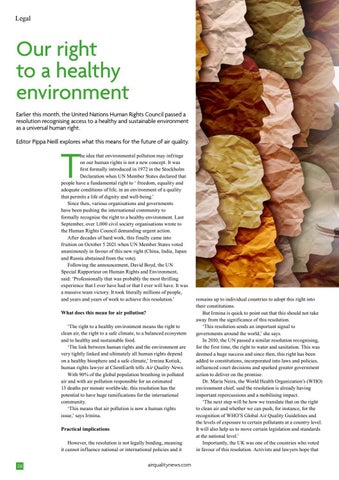Legal
Our right to a healthy environment Earlier this month, the United Nations Human Rights Council passed a resolution recognising access to a healthy and sustainable environment as a universal human right. Editor Pippa Neill explores what this means for the future of air quality.
T
he idea that environmental pollution may infringe on our human rights is not a new concept. It was first formally introduced in 1972 in the Stockholm Declaration when UN Member States declared that people have a fundamental right to ‘ freedom, equality and adequate conditions of life, in an environment of a quality that permits a life of dignity and well-being.’ Since then, various organisations and governments have been pushing the international community to formally recognise the right to a healthy environment. Last September, over 1,000 civil society organisations wrote to the Human Rights Council demanding urgent action. After decades of hard work, this finally came into fruition on October 5 2021 when UN Member States voted unanimously in favour of this new right (China, India, Japan and Russia abstained from the vote). Following the announcement, David Boyd, the UN Special Rapporteur on Human Rights and Environment, said: ‘Professionally that was probably the most thrilling experience that I ever have had or that I ever will have. It was a massive team victory. It took literally millions of people, and years and years of work to achieve this resolution.’ What does this mean for air pollution? ‘The right to a healthy environment means the right to clean air, the right to a safe climate, to a balanced ecosystem and to healthy and sustainable food. ‘The link between human rights and the environment are very tightly linked and ultimately all human rights depend on a healthy biosphere and a safe climate,’ Irmina Kotiuk, human rights lawyer at ClientEarth tells Air Quality News. With 90% of the global population breathing in polluted air and with air pollution responsible for an estimated 13 deaths per minute worldwide, this resolution has the potential to have huge ramifications for the international community. ‘This means that air pollution is now a human rights issue,’ says Irmina. Practical implications However, the resolution is not legally binding, meaning it cannot influence national or international policies and it
38
airqualitynews.com
remains up to individual countries to adopt this right into their constitutions. But Irmina is quick to point out that this should not take away from the significance of this resolution. ‘This resolution sends an important signal to governments around the world,’ she says. In 2010, the UN passed a similar resolution recognising, for the first time, the right to water and sanitation. This was deemed a huge success and since then, this right has been added to constitutions, incorporated into laws and policies, influenced court decisions and sparked greater government action to deliver on the promise. Dr. Maria Neira, the World Health Organization’s (WHO) environment chief, said the resolution is already having important repercussions and a mobilising impact. ‘The next step will be how we translate that on the right to clean air and whether we can push, for instance, for the recognition of WHO’S Global Air Quality Guidelines and the levels of exposure to certain pollutants at a country level. It will also help us to move certain legislation and standards at the national level.’ Importantly, the UK was one of the countries who voted in favour of this resolution. Activists and lawyers hope that








